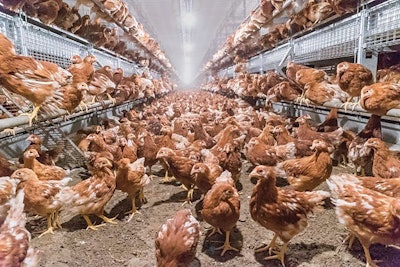
Coccidiosis is very common in the layer industry, but it is often missed if producers do not see mortality or bloody fecal droppings in the house, explained Kelli Jones, DVM, technical services veterinarian with Ceva Animal Health during the "Managing coccidiosis vaccination in layers" TechTalk, part of the International Production & Processing Expo (IPPE) Marketplace.
Other signs might include a drop in egg production, impaired growth rates, poor pigments in the eggs, lack of uniformity and many other secondary costs of coccidiosis in layers, in addition to your control cost, she noted.
Understanding the coccidiosis cycle
The coccidiosis life cycle is about seven days, depending on the species (there are five different species of coccidiosis) and it occurs both inside the bird and in the environment, she explained.
"Oocysts are the organisms that are involved and have to go through a called sporulation that occurs in the environment before they become infective," she said. In the bird's environment the unsporulated oocysts come out of the bird through feces, they must have certain factors to sporulate or become infective, Jones explained.
Sporulation, she noted, is a lot like incubation. Think of your oocysts as the egg, the environment as an incubator, and the right conditions (25% to 35% moisture, the right temperature, and oxygen available) and sporulation happens.
Internal cycle control
"The internal cycle starts in the hatchery and that's where vaccines come into play. We want the controlled exposure. We know the number of oocysts that need to be taken, we know the species involved, so we can use that and optimize the process," said Jones.
It's important to create a balancing act, where a protective uniform immune response is created with minimal intestinal damage.
Immunity development
"Unfortunately, only 20% of immunity is achieved by the hatchery vaccination, which means that it is up to you guys in the field to finish out that 80% immunity development. We need three full cycles of coccidiosis in the field to achieve this," Jones said.
Ideally, producers want a trickle infection so that the birds are not slammed with a lot of oocysts are one time. However, a repeated completion of the life cycle is needed and that takes about three weeks.
How do you know the flock is immunized?
After vaccination is complete and everything that could be done in the field was, there are three ways to assess immunity, she explained. Jones said they are:
- Reduction in pathogenic effects.
- Reduction in the extent of lesions.
- A decrease in the numbers of parasites.
Read more from IPPE Marketplace.















